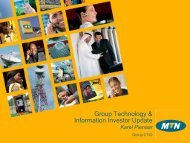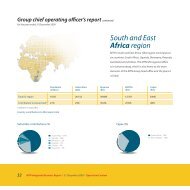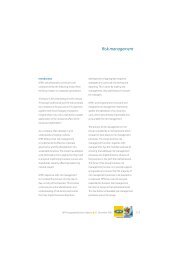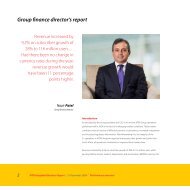(formely M-Cell Limited) - Business Report 2003 - MTN Group
(formely M-Cell Limited) - Business Report 2003 - MTN Group
(formely M-Cell Limited) - Business Report 2003 - MTN Group
Create successful ePaper yourself
Turn your PDF publications into a flip-book with our unique Google optimized e-Paper software.
issue during the period and is based on the earnings attributable to ordinary shareholders, after excluding<br />
those items as required by Accounting Issues Task Force opinion AC306.<br />
2.12 Provisions<br />
A provision is recognised when there is a legal or constructive obligation as a result of a past event for<br />
which it is probable that a transfer of economic benefits will be required to settle the obligation and a<br />
reliable estimate can be made of the amount of the obligation.<br />
The <strong>Group</strong> recognises a provision for onerous contracts when the expected benefits to be derived from a<br />
contract are less than the unavoidable costs of meeting the obligations under the contract.<br />
2.13 Deferred taxation<br />
Deferred taxation is provided, using the liability method, for all temporary differences arising between the<br />
tax bases of assets and liabilities and their carrying values for financial reporting purposes. Current enacted<br />
tax rates are used to determine deferred taxation.<br />
Under this method the <strong>Group</strong> is required to make provision for deferred taxation in relation to an<br />
acquisition, on the difference between the fair values of the net assets acquired and their tax base.<br />
Provision for taxes, mainly withholding taxes, which could arise on the remittance of accumulated profits,<br />
principally relating to subsidiaries, is only made where a decision has been made to remit such earnings.<br />
The principal temporary differences arise from depreciation on property, plant and equipment, working<br />
capital allowances and tax losses carried forward. Deferred taxation assets relating to the carry forward of<br />
unused tax losses, deductible temporary differences and tax credits are recognised to the extent that it is<br />
probable that future taxable profit will be available against which the unused tax losses, deductible<br />
temporary differences and tax credits can be utilised.<br />
No deferred tax is recognised if the temporary difference arises from goodwill or from the initial recognition<br />
of an asset which has no impact on accounting profit or taxable income.<br />
2.14 Property, plant and equipment<br />
Property, plant and equipment are stated at cost less accumulated depreciation. Cost includes all costs<br />
directly attributable to bringing the asset to working condition for its intended use. Land is not depreciated,<br />
and the depreciation of all other property, plant and equipment is calculated to write off the cost to its<br />
residual values on the straight-line basis over their expected useful lives as follows:<br />
Buildings 3,34% – 6,67%<br />
Information systems, furniture and office equipment 10% – 25%<br />
Network infrastructure 10% – 33%<br />
Aircraft and vehicles 20% – 25%<br />
Leasehold improvements<br />
Shorter of the term of the lease or five years<br />
Assets held under finance leases are depreciated over their expected useful lives on the same basis as<br />
owned assets or, where shorter, the expected term of the relevant lease.<br />
Subsequent expenditure relating to an item of property, plant and equipment is capitalised when it is<br />
probable that future economic benefits from the use of the asset will be increased.<br />
Repairs and maintenance are charged to the income statement during the financial period in which they<br />
are incurred.<br />
The gain or loss arising on the disposal or retirement of an asset is determined as the difference between<br />
the sale proceeds and the carrying amount of the asset.<br />
2.15 Impairment of assets<br />
The carrying amounts of the <strong>Group</strong>’s assets are reviewed at each balance sheet date to determine whether<br />
there is any indication of impairment. If there is any indication that an asset may be impaired, its recoverable<br />
amount is estimated. The recoverable amount is the higher of its net selling price and value in use.<br />
In assessing value in use, the expected future cash flows from the asset are discounted to their present<br />
value using a pre-tax discount rate that reflects current market assessments of the time value of money and<br />
the risks specific to the asset. An impairment loss is recognised whenever the carrying amount of an asset<br />
exceeds its recoverable amount.<br />
2.16 Other intangible assets<br />
Intangible assets that are considered to have an enduring benefit are stated at cost less accumulated<br />
amortisation and accumulated impairment losses (if applicable). Intangible assets are amortised to the<br />
<strong>MTN</strong> BUSINESS REPORT <strong>2003</strong><br />
PAGE 73
















